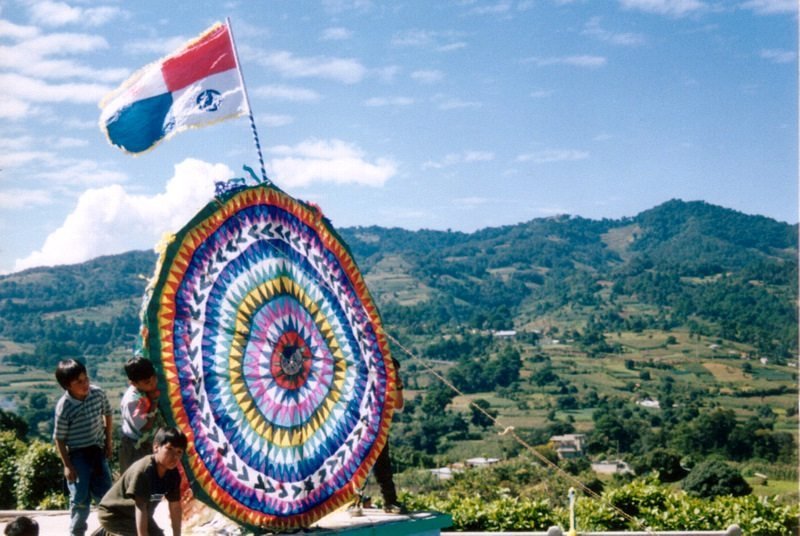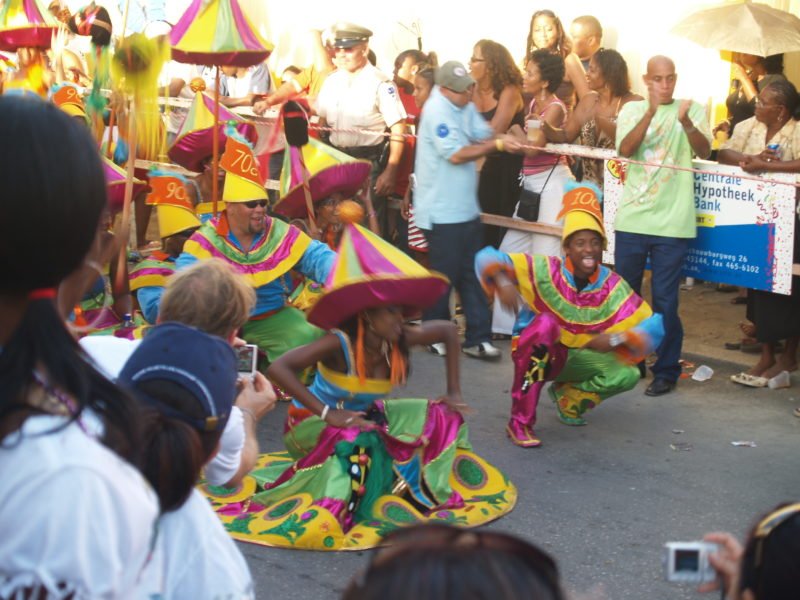Go Fly a Kite: Day of the Dead in Guatemala
 Crowds cheer as giant colorful homemade kites fill the skies competing to catch the sun. Bright orange and yellow flower petals cover the earth as if the previous night’s rain had magically fallen as blossoms. It might be an unlikely sight in a cemetery, but this is el Dia de Todos los Santos, All Saints’ Day, a holiday that celebrates family and remembers departed loved ones. Every November 1 the tiny town of Santiago Sacatepequez, near Guatemala’s capital city, follows a tradition over 100 years old while tourists come from far and near to sit atop the graves in the cemetery and watch. Some kites are over six meters in diameter, and teams of as many as a dozen men work to get them airborne. And when they are successful it is truly a sight to behold.
Crowds cheer as giant colorful homemade kites fill the skies competing to catch the sun. Bright orange and yellow flower petals cover the earth as if the previous night’s rain had magically fallen as blossoms. It might be an unlikely sight in a cemetery, but this is el Dia de Todos los Santos, All Saints’ Day, a holiday that celebrates family and remembers departed loved ones. Every November 1 the tiny town of Santiago Sacatepequez, near Guatemala’s capital city, follows a tradition over 100 years old while tourists come from far and near to sit atop the graves in the cemetery and watch. Some kites are over six meters in diameter, and teams of as many as a dozen men work to get them airborne. And when they are successful it is truly a sight to behold.
Taking a local bus from Guatemala City, I went a day early to watch preparations. In the open market, where days before there was only the healthy rainbow of fresh produce, now there were heaps of glowing marigold buds and other bright flowers for sale for the festival. I followed the road up to the cemetery and found many people at work putting down fresh coats of pastel-colored paints on the tombs and headstones, using large hoes to shore up the tired mounds of the humbler graves, and spreading out bright, golden blankets of fresh flower blossoms.
 I walked to the end of the center path and looked out over the valley beyond. The cemetery sat at the top of a great hill and all the squares of cornfields lay across the verdant slopes like a patchwork quilt beneath the modest mountains. The sky was gray and cold, and the wind that swept among the headstones was ideal for kite flying, the kind of wind that one hears in old westerns with the low whistle as it slipped through the trees and corn tassels and over the colonial-style wall that enclosed the blessed earth. The wind was big, not just in terms of speed or force, but in the feeling of insignificance it created in the observer.
I walked to the end of the center path and looked out over the valley beyond. The cemetery sat at the top of a great hill and all the squares of cornfields lay across the verdant slopes like a patchwork quilt beneath the modest mountains. The sky was gray and cold, and the wind that swept among the headstones was ideal for kite flying, the kind of wind that one hears in old westerns with the low whistle as it slipped through the trees and corn tassels and over the colonial-style wall that enclosed the blessed earth. The wind was big, not just in terms of speed or force, but in the feeling of insignificance it created in the observer.
I asked around for someone who was flying one of the big kites the next day and a man in the cemetery gave me a name and address.
 Marco Antonio was about fifty years old, five foot two, with black hair going gray and a moustache. He welcomed me into his dining room where he had cleared out all the furniture, and went to the corner to unroll the kite. Composed of circling patterns of colored triangles, the four-meter kite nearly filled the room. He got down on his knees to show me how it was made. The big ones, he told me, take about a month to construct. They were made from small pieces of tissue paper glued together with a special homemade flour-and-water glue, and reinforced from behind with larger sheets of white tissue or sometimes newspaper. Work begins with a small round piece of cardboard to which the first circle of papers is applied, and then the kite expands in concentric bands. It took Marco Antonio five full days to finish his. I asked him what the hardest part was. “It hurts the knees,” he replied sheepishly.
Marco Antonio was about fifty years old, five foot two, with black hair going gray and a moustache. He welcomed me into his dining room where he had cleared out all the furniture, and went to the corner to unroll the kite. Composed of circling patterns of colored triangles, the four-meter kite nearly filled the room. He got down on his knees to show me how it was made. The big ones, he told me, take about a month to construct. They were made from small pieces of tissue paper glued together with a special homemade flour-and-water glue, and reinforced from behind with larger sheets of white tissue or sometimes newspaper. Work begins with a small round piece of cardboard to which the first circle of papers is applied, and then the kite expands in concentric bands. It took Marco Antonio five full days to finish his. I asked him what the hardest part was. “It hurts the knees,” he replied sheepishly.
He and his family have been making kites for 40 years, the tradition in the village is over 100 years old. Nowadays there are prizes for design and for length of flight. I admired his handiwork and he shrugged off the praise with a smile. He invited me back the next day to help attach the frame and put the final touches on the kite.
 Early the next morning his house was a whirlwind of activity. While the men prepared the kite, the women were making fiambre, a traditional dish made every year for this holiday. Fiambre is a sort of cold meat salad, and though there are various recipes, the dish generally contains every kind of meat available at the local butcher: ham, bacon, the range of sausages from longaniza to hot dogs to chorizo, beef cubes, beef tongue, and any variations on pork products that haven’t gotten in to begin with. Then a variety of vegetables, hard boiled eggs, and cubes of cheese. In the end a sort of vinaigrette is swirled into the mix and it is ready to serve. I had had it the night before at a local comedor.
Early the next morning his house was a whirlwind of activity. While the men prepared the kite, the women were making fiambre, a traditional dish made every year for this holiday. Fiambre is a sort of cold meat salad, and though there are various recipes, the dish generally contains every kind of meat available at the local butcher: ham, bacon, the range of sausages from longaniza to hot dogs to chorizo, beef cubes, beef tongue, and any variations on pork products that haven’t gotten in to begin with. Then a variety of vegetables, hard boiled eggs, and cubes of cheese. In the end a sort of vinaigrette is swirled into the mix and it is ready to serve. I had had it the night before at a local comedor.
All cousins, brothers, uncles, and fathers and sons had gathered for the last stage outside. Marco Antonio narrated for me as he went. The frame is made of eight long canes that must be cut in a full moon “so they will be strong,” he told me, and then they are laid out for at least three months to dry so that they are lighter. They laid the four-meter canes in a compass pattern and Marco Antonio bound them together at the center with a rope made locally from maguey. He indicated two massive balls of it like yarn for saber-toothed tiger kittens. One to two kilometers of it was required for the bigger kites. The rope was slightly thicker than my finger.
 The frame was tied up with a line run around the points of the canes, and then the kite was attached by curling its round edges over the circling rope and then pasting the kite fabric to itself. They added two layers of colored fringes to the entire edge and then attached a long tail fashioned from old clothing scraps. Then smaller canes with small tissue flags were attached to four of the top canes, jutting out like the crown of the Statue of Liberty.
The frame was tied up with a line run around the points of the canes, and then the kite was attached by curling its round edges over the circling rope and then pasting the kite fabric to itself. They added two layers of colored fringes to the entire edge and then attached a long tail fashioned from old clothing scraps. Then smaller canes with small tissue flags were attached to four of the top canes, jutting out like the crown of the Statue of Liberty.
The kites are still thought by some to be a way of communicating with the dead, Marco Antonio told me. Messages written on papers are attached to the kite rope and then slid up to the skies, a sort of spiritual telegram. He just shrugged off the more mythical elements of the event. He laughed, “It is only for fun now.” His own children were learning and no doubt already could direct the project on their own. But for now, he still played supervisor and all eyes turned to him when it came time to attach the rope to the giant frame. Marco Antonio carefully tied the loose end of one of the giant balls of rope to a rope triangle he had fastened to the frame through holes in the kite, and we were ready for flight.
 When all was finished, the men were called to the patio for lunch. We all sat around a row of mismatched tables and then the mothers brought out large bowls of fiambre. It is an intimidating dish for people who like to look at their food before putting it in their mouth, and definitely an acquired taste. I worked hard to acquire it without much success.
When all was finished, the men were called to the patio for lunch. We all sat around a row of mismatched tables and then the mothers brought out large bowls of fiambre. It is an intimidating dish for people who like to look at their food before putting it in their mouth, and definitely an acquired taste. I worked hard to acquire it without much success.
There are clubs and groups of friends that participate in the kite flying every year. Marco Antonio’s team was strictly family and so I felt extremely honored when they had handed me pieces to put in place, and later when we paraded through the cobblestone streets, the kite held above our heads, shouting directions and warnings as the road narrowed or light poles or awnings thrust out to tear the fabric.
 We marched through the uneven streets, where crowds of locals and tourists lined the streets shopping for small kites or enjoying the sudden plethora of savory street food. Smoke drifted through the air replete with the smell of grilled meat and roasting corn.
We marched through the uneven streets, where crowds of locals and tourists lined the streets shopping for small kites or enjoying the sudden plethora of savory street food. Smoke drifted through the air replete with the smell of grilled meat and roasting corn.
At the top of the hill the cemetery had been transformed. People wandered the grounds and some even picnicked or looked on from atop tombs. Along one wall of the cemetery massive decorative kites over twelve meters tall were propped up, exhibiting complex designs, political messages, Maya figures in tissue paper.
The winds were low, leaving us apprehensive, but the group was not to be discouraged. They tried repeatedly without success. It took nearly a dozen people to launch a kite of this size. They’d line up across the graves in three or four groups of two or three people. The first group held the kite erect until the signal. The second group would take hold of the rope and run while the first group kept the kite upright until it slipped up into the air. Once it was up, the second group released it to the third group who then also ran  with it, attempting to raise it yet further into the sky. At this point if it hadn’t plummeted out of the sky already, the fourth group took control and combined pulling and releasing techniques to work the monster kite toward the clouds. All this activity of course was done across the dearly departed.
with it, attempting to raise it yet further into the sky. At this point if it hadn’t plummeted out of the sky already, the fourth group took control and combined pulling and releasing techniques to work the monster kite toward the clouds. All this activity of course was done across the dearly departed.
When the winds failed to lift the kites, the beautiful creations and their jutting flags, became whirling death stars falling from the heavens, and everyone ran laughing for cover. Occasionally, someone got nicked and blood was drawn but at least in the time that I was there no one lost an eye or anything.
A couple of kites had managed to reach the stronger winds up high, but our group was repeatedly retrieving crash landings. About three hours later, however, magic took hold. We all stood mesmerized as  Marco Antonio, now alone with the rope of the fourth group, worked the line back and forth as the circular rainbow rustled into a partly cloudy sky. Whenever the sun broke through, the kite colors took fire.
Marco Antonio, now alone with the rope of the fourth group, worked the line back and forth as the circular rainbow rustled into a partly cloudy sky. Whenever the sun broke through, the kite colors took fire.
There were cheers all around and when it seemed certain the kite had the wind for good, Marco Antonio passed the line to others. Some time later he called my name. Others took it up in a chant. I stepped nervously to the plate. What if the kite took a nose dive when I was on the line? They cheered me on as I tried to imitate their method. Many shouted instructions, some unintelligible, others contradictory, so it was with some amount of relief that I relinquished the line to the next person. But that short moment at the end of that line, feeling the firm handshake of the wind, was magical.
_____________________________
Flights would be into Guatemala City (Airport code=GUA). Check our Travel Planner for prices.
The best place to stay is historic Antigua, a short ride from Guatemala City where you will find a wide range of hotels – from the super cheap to the elegant Posada del Angel (President Clinton stayed here in 1999). Search for hotels in Antigua, Guatemala





 ORDER YOUR COPY TODAY!
ORDER YOUR COPY TODAY! ORDER YOUR COPY TODAY!
ORDER YOUR COPY TODAY!
Pingback: Halloween in Madison: Freakfest 2011 Photos
Pingback: Spirits flying high: Day of the Dead in Guatemala « Mayan Threads
Pingback: The Mad Traveler’s A to Z of Travel